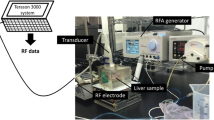Abstract
Identifying arrhythmia substrates and quantifying their heterogeneity has great potential to provide critical guidance for radio frequency ablation. However, quantitative analysis of heterogeneity on cardiac optical coherence tomography (OCT) images is lacking. In this paper, we conduct the first study on quantifying cardiac tissue heterogeneity from human OCT images. Our proposed method applies a dropout-based Monte Carlo sampling technique to measure the model uncertainty. The heterogeneity information is extracted by decoupling the intra/inter-tissue heterogeneity and tissue boundary uncertainty from the uncertainty measurement. We empirically demonstrate that our model can highlight the subtle features from OCT images, and the heterogeneity information extracted is positively correlated with the tissue heterogeneity information from corresponding histology images.
Access this chapter
Tax calculation will be finalised at checkout
Purchases are for personal use only
Similar content being viewed by others
References
Aslanidi, O.V., Boyett, M.R., Dobrzynski, H., Li, J., Zhang, H.: Mechanisms of transition from normal to reentrant electrical activity in a model of rabbit atrial tissue: interaction of tissue heterogeneity and anisotropy. Biophysical J. 96(3), 798–817 (2009)
Baues, M., et al.: Fibrosis imaging: current concepts and future directions. Adv. Drug Deliv. Rev. 121, 9–26 (2017)
Buch, K., et al.: Using texture analysis to determine human papillomavirus status of oropharyngeal squamous cell carcinomas on CT. AJNR Am. J. Neuroradiol. 36(7), 1343–1348 (2015)
Cua, M., et al.: Morphological phenotyping of mouse hearts using optical coherence tomography. J. Biomed. Opt. 19(11), 116007 (2014)
Fleming, C.P., Rosenthal, N., Rollins, A.M., Arruda, M.: First in vivo real-time imaging of endocardial RF ablation by optical coherence tomography. J. Innov. Card. Rhythm Manag. 2, 199–201 (2011)
Fujima, N., et al.: The utility of MRI histogram and texture analysis for the prediction of histological diagnosis in head and neck malignancies. Cancer Imaging 19(1), 5 (2019)
Gal, Y., Ghahramani, Z.: Dropout as a bayesian approximation: representing model uncertainty in deep learning. In: International Conference on Machine Learning. pp. 1050–1059 (2016)
Gan, Y., Lye, T.H., Marboe, C.C., Hendon, C.P.: Characterization of the human myocardium by optical coherence tomography. J. Biophotonics 12(12), e201900094 (2019)
Gan, Y., Tsay, D., Amir, S.B., Marboe, C.C., Hendon, C.P.: Automated classification of optical coherence tomography images of human atrial tissue. J. Biomed. Opt. 21(10), 101407 (2016)
Goergen, C.J., et al.: Optical coherence tractography using intrinsic contrast. Opt. Lett. 37(18), 3882–3884 (2012)
Haissaguerre, M., et al.: Intermittent drivers anchoring to structural heterogeneities as a major pathophysiological mechanism of human persistent atrial fibrillation. J. Physiol. 594(9), 2387–2398 (2016)
Hsiung, P.L., Nambiar, P.R., Fujimoto, J.G.: Effect of tissue preservation on imaging using ultrahigh resolution optical coherence tomography. J. Biomed. Opt. 10(6), 064033 (2005)
Hu, S., et al.: Supervised uncertainty quantification for segmentation with multiple annotations. In: Shen, D., et al. (eds.) MICCAI 2019. LNCS, vol. 11765, pp. 137–145. Springer, Cham (2019). https://doi.org/10.1007/978-3-030-32245-8_16
Braunmühl, T.: Optical coherence tomography. Der Hautarzt 66(7), 499–503 (2015). https://doi.org/10.1007/s00105-015-3607-z
Kather, J.N., et al.: Multi-class texture analysis in colorectal cancer histology. Scientific Reports 6, 27988 (2016)
Kendall, A., Badrinarayanan, V., Cipolla, R.: Bayesian segnet: Model uncertainty in deep convolutional encoder-decoder architectures for scene understanding. arXiv preprint arXiv:1511.02680 (2015)
Khurshid, S., et al.: Frequency of cardiac rhythm abnormalities in a half million adults. Circ. Arrhythm Electrophysiol. 11(7), e006273 (2018)
Laplante, P.: Encyclopedia of Image Processing. CRC Press, United States (2018)
Lin, T.Y., Goyal, P., Girshick, R., He, K., Dollár, P.: Focal loss for dense object detection. In: IEEE International Conference on Computer Vision. pp. 2980–2988 (2017)
López, B., et al.: Circulating biomarkers of myocardial fibrosis: the need for a reappraisal. J. Am. Coll. Cardiol. 65(22), 2449–2456 (2015)
Lye, T.H., Iyer, V., Marboe, C.C., Hendon, C.P.: Mapping the human pulmonary venoatrial junction with optical coherence tomography. Biomed. Opt. Express 10(2), 434–448 (2019)
Mukaka, M.: A guide to appropriate use of correlation coefficient in medical research. Malawi Med. J. 24(3), 69–71 (2012)
Rotimi, O., Cairns, A., Gray, S., Moayyedi, P., Dixon, M.: Histological identification of helicobacter pylori: comparison of staining methods. J. Clin. Pathol. 53(10), 756–759 (2000)
Roy, A.G., et al.: Relaynet: retinal layer and fluid segmentation of macular optical coherence tomography using fully convolutional networks. Biomed. Opt. Express 8(8), 3627–3642 (2017)
Schober, P., Boer, C., Schwarte, L.A.: Correlation coefficients: appropriate use and interpretation. Anesthesia & Analgesia 126(5), 1763–1768 (2018)
Sedai, S., Antony, B., Mahapatra, D., Garnavi, R.: Joint segmentation and uncertainty visualization of retinal layers in optical coherence tomography images using bayesian deep learning. In: Stoyanov, D., et al. (eds.) OMIA/COMPAY -2018. LNCS, vol. 11039, pp. 219–227. Springer, Cham (2018). https://doi.org/10.1007/978-3-030-00949-6_26
Srivastava, N., Hinton, G., Krizhevsky, A., Sutskever, I., Salakhutdinov, R.: Dropout: a simple way to prevent neural networks from overfitting. J. Mach. Learn. Res. 15(1), 1929–1958 (2014)
Tereshchenko, L.G., et al.: Infiltrated atrial fat characterizes underlying atrial fibrillation substrate in patients at risk as defined by the aric atrial fibrillation risk score. Int. J. Cardiol. 172(1), 196–201 (2014)
Wei, L., Gan, Q., Ji, T.: Cervical cancer histology image identification method based on texture and lesion area features. Comput. Assist. Surg. 22(sup1), 186–199 (2017)
Zhao, X., et al.: Integrated RFA/PSOCT catheter for real-time guidance of cardiac radio-frequency ablation. Biomed. Opt. Express 9(12), 6400–6411 (2018)
Acknowledgements
The study was funded in part by the National Institute of Health (4DP2HL127776-02 and 1R01HL149369-01, CPH), the National Science Foundation Career Award (1454365, CPH).
Author information
Authors and Affiliations
Editor information
Editors and Affiliations
Rights and permissions
Copyright information
© 2020 Springer Nature Switzerland AG
About this paper
Cite this paper
Huang, Z. et al. (2020). Heterogeneity Measurement of Cardiac Tissues Leveraging Uncertainty Information from Image Segmentation. In: Martel, A.L., et al. Medical Image Computing and Computer Assisted Intervention – MICCAI 2020. MICCAI 2020. Lecture Notes in Computer Science(), vol 12261. Springer, Cham. https://doi.org/10.1007/978-3-030-59710-8_76
Download citation
DOI: https://doi.org/10.1007/978-3-030-59710-8_76
Published:
Publisher Name: Springer, Cham
Print ISBN: 978-3-030-59709-2
Online ISBN: 978-3-030-59710-8
eBook Packages: Computer ScienceComputer Science (R0)





